Home »
The Ford Transit Custom towing capacity is amongst the best in the medium van segment where the Transit Custom is the undeniable leader. Bought by UK van drivers in their thousands, the Transit Custom not only has a great ability to tow but is a comfortable, safe and economical van to be in.
The Ford Transit Custom towing capacity is up to 2.5-tonnes or 2,500kg. This is the total towing capacity for a Transit Custom with a braked trailer.
For an unbraked trailer is it also possible to tow up to 750kg with a Ford Transit Custom.
The Transit Custom towing capacity is what you would expect for a medium van and is an improvement over past versions which had a towing maximum of up to 2000kg. The improved 2,500kg towing capacity puts it at the top of the medium van segment along with rivals like the towing capacity of the Vauxhall Vivaro.
Each Ford Transit Custom van has the same towing capacity of 2.5-tonnes regardless of the model or engine power. Because there are 110hp, 136hp, 150hp or 170hp engines it’s important to consider that if you plan to tow a full trailer, or even a caravan, boat or car, using the Transit Custom it will be easier if you have the most powerful model.
Although simply saying that the Transit Custom can tow 2.5-tonnes makes it a nice and tidy answer, it’s not quite that simple.
Vans have a designated weight they are allowed to carry called the gross vehicle mass. This is the weight of the van (its kerb weight) plus the weight of any occupants or payloads.
There’s then the gross combination weight (GCW), also known as the gross train weight (GTW) which is the weight of the vehicle plus any load in the cargo area plus the weight of whatever you are towing.
The Ford Transit Custom towing limit is therefore the GCW which can be affected by the payload.
The Transit Custom has several permitted gross combination weights (GCW) ranging from 4,825kg to 5,725kg depending on the variants. A detailed breakdown of the GCWs is listed below which covers the engine size and gross vehicle weight (GVW) of the vans.
The GVW – which is the weight of the van plus the maximum payload – is limited to 3.2-tonnes, giving the Transit Custom a maximum GCW of 5,725kg. If you factor in the 3,225kg GVW you’ll see that 2.5-tonnes is the maximum possible towing weight for the trailer plus its payload. This means that even if fully loaded you won’t exceed the combined weights of the van plus trailer.
| Transit Custom GCW - Maximum (kg) | T280 | T300 | T320 |
|---|---|---|---|
| 2.0L TDCi Ford EcoBlue 110 PS (80 kW) | 4825 | 5025 | _ |
| 2.0L TDCi Ford EcoBlue 136 PS (100 kW) | 5325 | 5525 | 5725 |
| 2.0L TDCi Ford EcoBlue 136 PS (100 kW) 8-speed automatic | 5325 | 5525 | 5725 |
| 2.0L TDCi Ford EcoBlue 150 PS (110 kW) | _ | 5525 | 5725 |
| 2.0L TDCi Ford EcoBlue 170 PS (125 kW) 8-speed automatic | _ | 5525 | 5725 |
But you can see that if you have a Transit Custom 300 with a 110hp engine that allowance is drastically reduced. Here the 5025kg GCW and the 3025kg GVW of the Transit Custom means that there is just a 2-tonne towing capacity, if the van is fully laden.
Our advice is to consult the weight plates for the vehicle towing capacity and the Ford Transit Custom payload. These will usually be found inside the door frames – usually the passenger side – or under the bonnet.
The Transit Custom doesn't come with a tow bar as standard, but there is an option for it in the lengthy list of extras. A fixed tow bar can be specified for towing large items of up to 2.5 tonnes. The optional tow bar is designed to be fully compatible with the vehicle’s electrical system with a 13-pin connection to enable brake lights linked to the van to be shown on a trailer.
Prices for the tow bar and electrics are, at the time of writing, listed at £430 while a retractable tow bar for the Transit Custom is £550 (ex VAT).
The Ford Transit is the backbone of Britain for a reason, the Ford Transit towing capacity is unrivalled in the large van sector. The Ford Transit has the towing weight of a heavyweight boxer. It pulls no punches and the Ford Transit tow rating is as good as you'll find in the large van segment.
The Ford Transit van has a towing capacity of 3.5 tonnes or 3,500kg (7716 lbs) which is the weight a Transit can tow at its absolute maximum. This is the applicable to the all 3.5-tonne GVW models as well as some of the larger weight vans - the ones with double wheels.
The maximum Ford Transit towing weight is 3500kg for a braked trailer. The maximum unbraked trailer weight is 750kg. There are a few exceptions for smaller vehicles as to what size of braked trailer they are capable of pulling.
The Transit comes in smaller sizes with vans of a 2.9-, 3.1- and 3.3-tonnes. This poses a few problems for the overall towing capacity of the Transit because the GVW alters the gross train weight (GTW) - also known as gross combination weight (GCW) - of the van.
Ford makes it really nice and easy to figure out which van you've got. That's because you'll probably know that the large Transit vans are often referred to as Transit 350. The clue here is that the 350 part is in reference to its GVW of 3.5 tonnes.
The smaller models are therefore known as follows:
If you need to know about the Transit dimensions or the Transit payload we have handy guides which also explain these weights and sizes, but those are the basics you need to know about the Ford Transit weight for towing.
It sure can, a Transit van could tow a standard unbraked trailer as well as a proper braked trailer suitable for pulling a car.
You need to be mindful of what you put on the trailer that the Transit van is towing, but as it has such a high towing capacity of 3500kg most vehicles will be ok.
It does depend on the maximum weight of the car, boat, mobile home, jet ski or whatever else it is you fancy towing. The total payload on the trailer, plus the weight of the trailer itself, must not exceeded the Transit towing capacity. As most trailers are built to be light this shouldn't alter now much your Transit van can tow, but it's important to keep the overall total in mind for a couple of reasons.
Firstly, the weight of the trailer forms part of the towing allowance. The trailer weight is also part of the overall gross train weight (GTW) of the Transit van and trailer towing combination. Importantly includes the van, the people in the van and any other contents in the van - keep reading and you'll understand why this is a really crucial factor in the towing capacity.
The Ford Transit has a gross train weight of up to 7-tonnes or 7,000kg (15,432 lbs) for the very largest twin wheel vans. The other sub 3.5-tonne vans have a GTW of 5,000kg (11,023 lbs).
But what is GTW and why does it affect what I can tow? Well, the gross train weight is the total weight of the van plus the weight of anything you are towing, so imagine you've filled a 3.5-tonne Transit van completely full of weight but then you need to tow something.
The total of the Transit, plus fuel, plus your weight, any passengers and whatever you have in the cargo area has an overall weight of 3500kg. In order to not exceed the total allowable GTW of 5500kg you must therefore not tow anything more than 2000kg.
If you want to maximise your towing capacity and tow a full 3500kg - the maximum the Transit is safely allowed to tow, so as not to damage the chassis or towing arm - then you'll have to lower the amount of weight you are carrying.
The Ford Transit tow bar isn't a standard fit item but it can be specified as an option on all models. The tow bar for the Transit costs just £400 as an option and depending on the spec of the vehicle you have gone for (ie. which trim it is, Limited, Trend etc) it will also then come with Trailer Sway Control. This is a safety feature designed to stop the trailer from snaking around when it becomes unstable.
Despite the size of a Ford Transit it is still possible to tow it. The Ford Transit has a dedicated towing eye with the mounting point. The Transit towing eye location is in the front of the grille.
First you need to get the towing eye which can be found under the passenger seat of the Transit - it's usually bolted to the floor.
You then need to connect the towing eye to the front of the van. The location to put the towing eye on the Transit is behind a small circular cover to the side of the numberplate and next to the headlight.

You'll need to push the circle in and use a plastic device (so as not to scratch the paint) to prize the cover out. Simply insert the Transit's towing eye into the recessed hole and screw it into place. You can now insert a towing rope into the hole.
As well as using and above towing eye for the front of the vehicle there is also a towing eye loop at the rear of the Transit. It's a small loop under the rear bumper that you can see if you duck down a little bit behind the van.
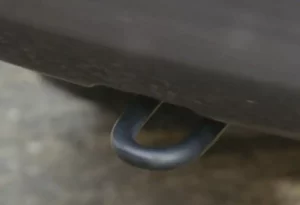
You can use it for winching the Transit van if it gets stuck so it will help with recovery. It's not to be used for towing in the same way as the dedicated towing eye mentioned above.
The Vauxhall Vivaro has a towing capacity of up to 2.5-tonnes or 2,500kg. That is the total towing capacity for a braked trailer on the latest van.
It is also possible to tow an unbraked trailer of up to 750kg using a Vauxhall Vivaro.
The Vivaro towing capacity is above average for a mid-sized van. Previous versions were only capable of towing up to 2000kg, but the newest model can pull an improved 2,500kg. That makes the towing capacity of the Vauxhall Vivaro better than some of the competition, however, it is still well below the maximum that you will find on large vans like the towing capacity of a Sprinter van, or even a pick-up truck.
Whether or not it is any good for towing will also depend on which model you decide to buy. All Vivaro vans have the same towing capacity of 2.5-tonnes, irrespective of which engine they have. With 125hp and 145hp variants to choose from if you plan to tow a full trailer using the Vivaro it would be best to go for the more powerful model.
It’s not as straight-forward as saying that the Vivaro can simply tow 2.5-tonnes and that’s the end of the matter. There’s also the vehicles entire weight to consider, or the gross combination weight (GCW) or gross train weight (GTW). This is the weight of the vehicle, plus any load in the cargo area, plus the weight of whatever you are towing. This is what makes up the entire Vauxhall Vivaro towing limit, in other words its Van + Payload + Trailer.
Fortunately, this is more simple than in most vans, as the all but the double cab variants have a gross combination weight (GCW) of 5.6-tonnes or 5600kg.
Given that the gross vehicle weight (GVW) which is the weight of the van plus the maximum payload is limited to 3.1-tonnes for the very largest models, adding on the 2.5-tonnes possible for the weight of the trailer plus its payload means that you won’t fall foul of exceeding the combined weights of the van and trailer, even if you ware fully laden.
There is a slight snag. If you have the 1.5-litre engine, it gets a slightly lower gross vehicle weight of 2830kg. That means that you’ll have to be slightly more cautious with the amount of payload you put in the back of the van.
As always, our advice is to check the towing capacity and the Vauxhall Vivaro payload capacity on the plates for the vehicle. These can often be found either inside the door frames – usually the passenger side – or under the bonnet.
Vauxhall Vivaros do not come with a towbar as standard, but they can be added as a factory spec item. The ball and hook tow bar option on the Vivaro is an option for all vans and adds a 13-pin connector plug for the wiring up of a towing bar. At the time of writing it costs around £700 for the Vivaro towbar.
If you want to know how to tow a Vivaro you’ll need to find the towing eye. The towing eye location is found under the front bumper, off the side of the main chassis arm. You’ll have to get under the front of the van in order to find the towing eye, and you will also need to be considerate of the bumper itself when towing.
The Mercedes-Benz Sprinter is the largest van in the Mercedes range and have a towing capacity to match. In fact, the Sprinter is so good at towing that it can tow an elephant - pictures don't lie.
The majority of Mercedes Sprinter vans have a towing capacity of 3.5-tonnes or 3,500kg (7716 lbs). This is how much weight a Sprinter can tow as a maximum and is applicable for the 3.5-tonne GVW models and larger 5- and 5.5-tonne vans. Smaller vans with a GVW of only 2.8-tonnes can tow just 2-tonnes or 2,000kg (4400 lbs).
The easiest way to check your towing capacity is to look at the vehicle plating weights on the door frame of the van, or under the bonnet. These will tell you exactly what the Sprinter van can tow as well as giving the GVW and the Sprinter payload.
However, the badges on the back of the Sprinter give you a clue as to its size. Mercedes produce models with numbers like the Sprinter 215, 315, 317, 319 and 515, 517 and 519 which denote the gross weights of the vans. The 2xx-series are capable of towing the smaller 2-tonne capacity, while the 3xx-series and 5xx-series can tow the higher weights of up to 3.5-tonnes.
Yes, a Sprinter van could tow a car but it all depends on the maximum weight of the car which will determine if you have exceeded the Sprinter towing capacity. As most cars are under 3.5-tonnes, the majority of cars can be towed by a Sprinter van, but you must also factor in the weight of the trailer (assuming you are using one) and consider the overall gross train weight (GTW) of the van and car combination.
The Mercedes-Benz Sprinter has a gross train weight of up to 7-tonnes or 7,000kg (15,432 lbs). That's for the very largest vans in the 5-series of weight category. The more standard 3.5-tonne vans have a GTW of 5,000kg (11,023 lbs).
So, what is GTW and why does it affect what I can tow?
Well the gross train weight is the total weight of the van plus the weight of anything you are towing.
For example, the easiest way to understand this is to imagine you've filled a 3.5-tonne Sprinter van completely full of weight. The total of the Sprinter, plus fuel, plus your weight, any passengers and whatever you have in the cargo area has an overall weight of 3500kg. In order to not exceed the total allowable GTW of 5500kg you must therefore not tow anything more than 2000kg.
If you want to maximise your towing capacity and tow a full 3500kg - the maximum the Sprinter is safely allowed to tow, so as not to damge the chassis or towing arm - then you'll have to lower the amount of weight you are carrying. To figure out the maximum you can carry it is therefore: Gross Train Weight minus kerbweight = maximum towing capacity.
The tables below will help explain the towing weights for the Euro 6 and Euro VI versions of the Sprinter.
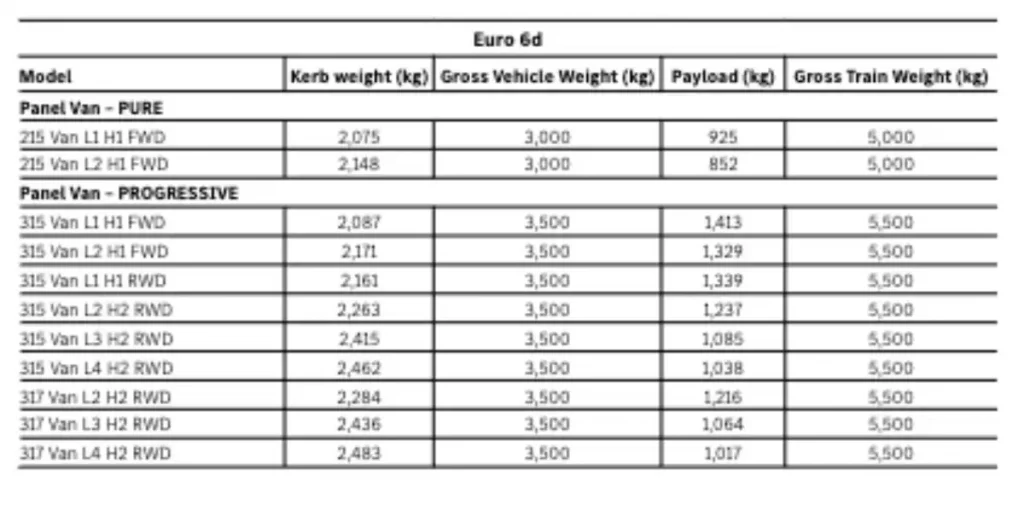
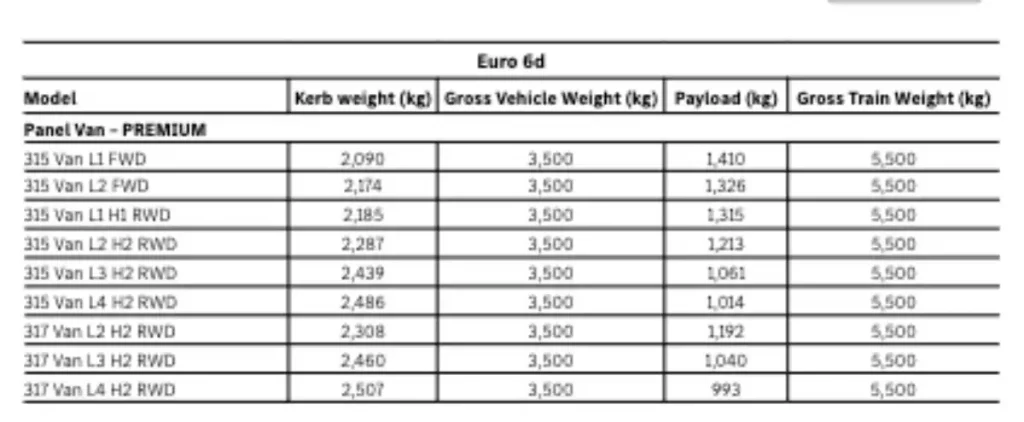
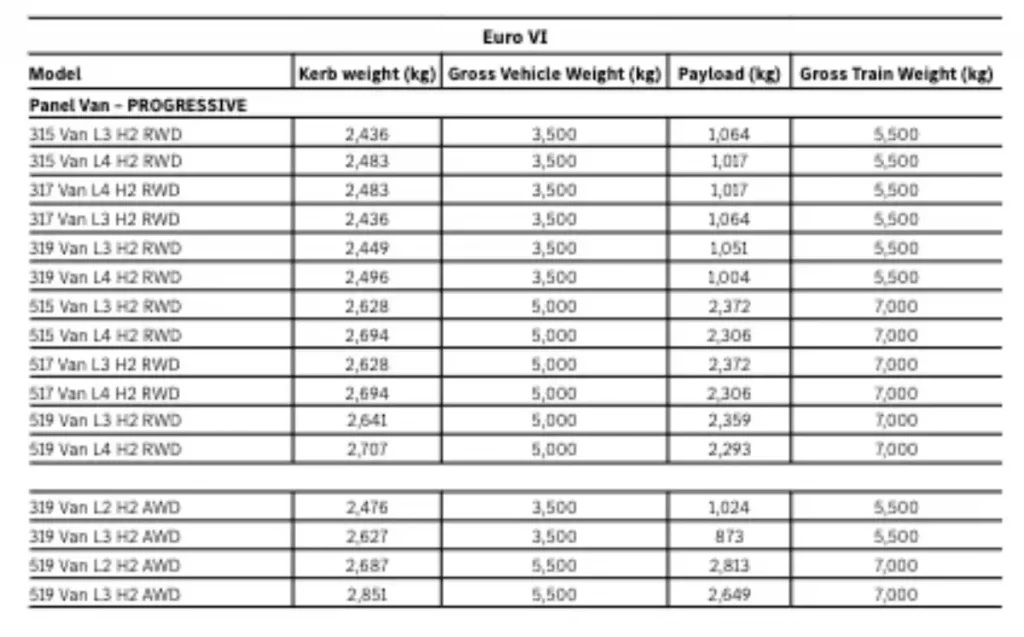
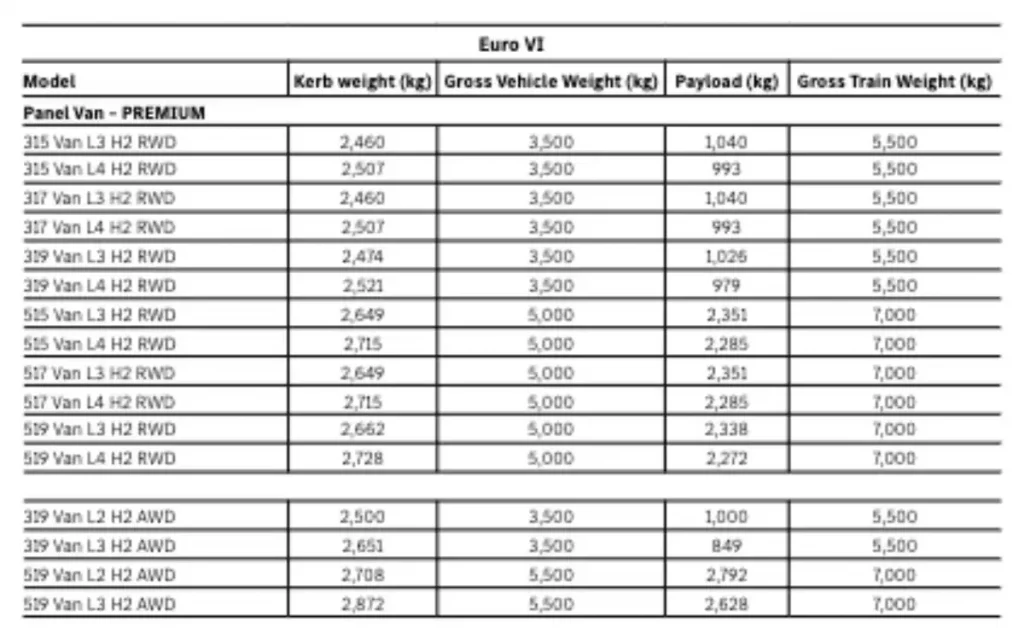
The only Sprinter models capable of carrying the complete 3.5-tonnes are the Sprinter 515, Sprinter 517 and Sprinter 519. Their 7-tonne GTW minus kerbweight of roughly 2.7-tonne (depending on version) is comfortable enough to tow a full weight trailer combination with some payload in the cargo space.
The best of the other models is the Sprinter 315 which can roughly tow 3,400kg. However, that is a front-wheel-drive (FWD) model which may not be most suitable for towing heavy loads. A rear-wheel-drive (RWD) variant would be more suitable and for that you'll need a Sprinter 315 RWD which can tow a maximum of 3,339kg.
No, the Sprinter doesn't come with a tow bar fitted as standard but it is easy enough to specify one from the options list. There are even a couple of Sprinter tow bar types to choose from with a fixed coupling head (c. £650) and a removable trailer coupling ball (£900). You can then decide if the tow bar for the Sprinter needs a trailer socket for a 13-pin electrical system (£300) and there are various enhanced towing capacity options depending on what GVW van you have.
The Sprinter towing eye can be found in the toolkit of the van which is normally located in a drop down panel in the door of the van. In there you'll find the towing eye which needs to be put into the front bumper in order to tow a Sprinter. There's a small square-shaped panel in the lower portion of the front bumper to the side of the numberplate. Pop this cover off using something like a flat head screw driver and simply screw the towing eye into the Sprinter.